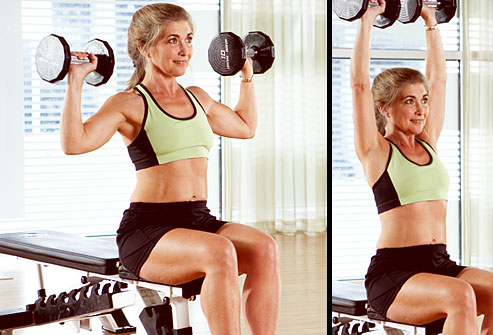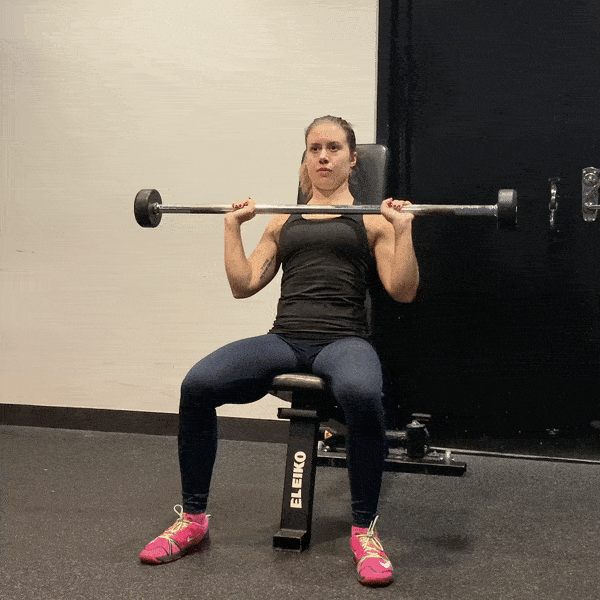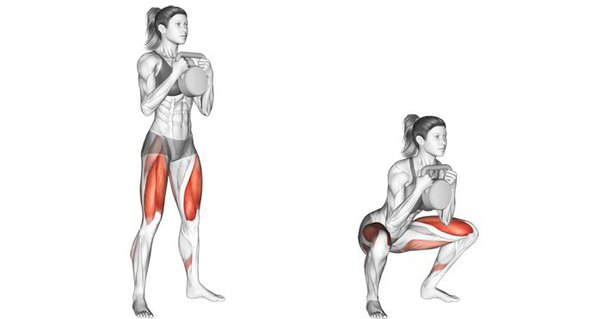When it comes to targeting the shoulders and building upper body strength, the Front Press and Shoulder Press are indispensable exercises with distinct advantages. While both share the commonality of pressing weight overhead, they diverge significantly in their execution and impact on muscle groups. The Front Press, executed with a barbell, emphasises comprehensive deltoid development along with engagement from the triceps and upper chest. In contrast, the Shoulder Press offers versatility through various equipment choices like dumbbells or machines, allowing for targeted shoulder strength and engagement of supporting muscles such as the triceps, upper trapezius, and core. Understanding these differences empowers individuals to tailor their workout routines effectively, optimising shoulder development and overall upper body strength.
Let's delve deeper into these exercises to understand their distinct characteristics and how they can enhance your workout routine.
Key Differences Between Front Press and Shoulder Press
Here's a detailed comparison of the key differences between the Front Press and Shoulder Press:
| Aspect | Front Press | Shoulder Press |
| Equipment Used | Barbell | Barbells, dumbbells, or machines |
| Muscle Emphasis | Comprehensive deltoid development | Targeted shoulder strength and muscle mass |
| Additional Muscles Engaged | Triceps, upper chest, core | Triceps, upper trapezius, upper chest, core |
| Stabilization | Core stabilization required | Core stabilization depending on the variation |
| Variations Available | Front Shoulder Press, Incline/Decline variations | Dumbbell Shoulder Press, Machine Shoulder Press |
Understanding Front Press
The Front Press, also referred to as the Front Shoulder Press or Barbell Front Press, is a fundamental compound exercise that primarily targets the deltoid muscles of the shoulders. Here's an in-depth look at the key features associated with the Front Press:
Execution
The Front Press involves lifting a barbell overhead while standing or seated, emphasizing shoulder strength and stability. The movement requires pressing the weight directly above the head with a controlled form.
Equipment Used
Typically performed with a barbell, the Front Press necessitates a grip slightly wider than shoulder-width apart to ensure proper control and balance throughout the movement.
Muscles Worked

The Front Press primarily targets the deltoid muscles, including the front (anterior), side (lateral), and rear (posterior) deltoids. Each part of the deltoid plays a specific role in lifting and stabilizing the weight overhead:
Front Deltoid (Anterior)
- Located at the front of the shoulder, the front deltoid is responsible for initiating the movement by lifting the weight from shoulder height to overhead.
Side Deltoid (Lateral)
- Positioned on the lateral aspect of the shoulder, the side deltoid assists in raising the weight to shoulder height and contributes to lateral arm movement during the press.
Rear Deltoid (Posterior)
- Situated at the back of the shoulder, the rear deltoid supports shoulder extension and provides stability during the lowering phase of the Front Press.
Additional Muscles Engaged
In addition to the deltoids, the Front Press activates synergistic muscles such as the triceps (back of the upper arm) and upper chest (pectoralis major), which assist in stabilizing the shoulders and contributing to the pressing movement.
Benefits of Front Press
- Comprehensive Shoulder Development, Targets all three heads of the deltoid muscles (front, side, rear), promoting balanced muscle growth across the shoulders.
- Enhanced Upper Body Strength and Stability, Engages supporting muscle groups such as triceps and upper chest, contributing to the pressing movement and providing stability during the lift.
- Core Activation, Requires significant core activation to maintain proper posture throughout the exercise, aiding in overall balance and strength.
- Functional Fitness, Incorporating the Front Press into your routine can lead to improved shoulder development and overall functional fitness.
How to Perform Front Press
- Stand with feet shoulder-width apart and grip the barbell with a slightly wider than shoulder-width grip.
- Rest the barbell on the front of your shoulders, keeping elbows pointed forward.
- Engage your core and maintain a neutral spine.
- Press the barbell directly overhead by extending your arms upward.
- Lower the barbell back down to shoulder height in a controlled manner, maintaining stability and control throughout the movement.
Understanding Shoulder Press
The term "Shoulder Press" encompasses a variety of overhead pressing exercises that target the shoulders. From barbell presses to dumbbell variations, the Shoulder Press offers versatility in equipment usage and grip variations.
Equipment Used
Shoulder Press exercises can be performed with barbells, dumbbells, or machines, allowing for different grip widths and hand positions to accommodate individual preferences.
Muscles Worked
The Shoulder Press primarily targets the deltoid muscles but also engages several other muscle groups to support the movement and stabilize the body:
Front Deltoid (Anterior)
- Actively engaged during the lift, especially when raising the weight from shoulder height to overhead.
Side Deltoid (Lateral)
- Assists in lifting the weight to shoulder height and contributes to lateral arm movement during the press.
Rear Deltoid (Posterior)
- Supports shoulder stability and assists in controlling the weight during the lowering phase.
Additional Muscles Engaged
In addition to the deltoids, the Shoulder Press activates muscles such as the triceps, upper trapezius, upper chest, and core for stabilisation and support.
Benefits of Shoulder Press
- Shoulder Muscle Development, Targets the deltoid muscles (front, side, rear), promoting overall shoulder strength and size.
- Versatility, Can be performed with various equipment (barbells, dumbbells, machines) and grips, allowing for flexibility in training.
- Engages Supporting Muscles, Involves triceps, upper chest, and core muscles to assist in stabilising and executing the pressing movement.
- Improves Upper Body Stability, Strengthens the muscles responsible for shoulder stability, which is essential for many daily activities and sports.
- Functional Strength, Enhances the ability to lift objects overhead and perform pressing movements in daily life or sports activities.
How to Perform Shoulder Press with Dumbbells:
- Sit on a bench with back support or stand with feet shoulder-width apart.
- Hold a dumbbell in each hand at shoulder height, palms facing forward, with elbows slightly bent.
- Brace your core and maintain a neutral spine.
- Press the dumbbells overhead simultaneously by extending your arms upward.
- Keep the dumbbells close to your body and avoid arching your back excessively.
- Lower the dumbbells back down to shoulder height in a controlled manner, maintaining stability and control throughout the movement.
Choosing the Right Exercise
Selecting between the Front Press and Shoulder Press depends on individual goals, equipment availability, and training preferences. Both exercises offer unique benefits for shoulder development and upper body strength. Beginners may start with Shoulder Press variations using dumbbells to master proper form before progressing to more advanced exercises like the Front Press.
For Beginners
Those new to strength training may benefit from starting with Shoulder Press variations using dumbbells. This approach allows beginners to focus on mastering proper form and technique before progressing to more advanced exercises like the Front Press. Dumbbells provide greater freedom of movement and require increased stabilisation, which can help build foundational strength and coordination.
Intermediate to Advanced
As individuals advance in their training and become more comfortable with overhead pressing movements, incorporating the Front Press can provide a new challenge. The Front Press requires greater shoulder stability and engages the triceps and upper chest more prominently due to the barbell's positioning in front of the body.
Equipment Considerations
Equipment availability can also influence exercise selection. If barbells are readily accessible, individuals may choose to incorporate the Front Press into their routine to take advantage of its unique benefits. Conversely, if only dumbbells are available, various Shoulder Press variations can still be effectively utilised to achieve shoulder development and upper body strength.
Training Objectives
Ultimately, the choice between the Front Press and Shoulder Press should align with specific training objectives. Those seeking to build overall shoulder strength and stability may prefer the Front Press, while individuals focusing on refining shoulder mechanics and coordination may opt for Shoulder Press variations with dumbbells. By understanding these considerations, individuals can tailor their exercise selection to maximise results and progression in their strength training journey.
Answering some FAQs
Q.Is shoulder press better than front press?
A.The comparison between shoulder press and front press ultimately depends on individual fitness goals and preferences. Each exercise offers unique benefits and targets different muscle groups. The shoulder press primarily emphasises the deltoid muscles, along with engaging the triceps, upper chest, and core for stabilisation. On the other hand, the front press also targets the deltoids comprehensively but places additional emphasis on the upper chest and triceps due to the barbell's position in front of the body. Therefore, neither exercise is inherently "better" than the other; instead, they serve as complementary movements that can be incorporated into a well-rounded strength training routine based on specific objectives and training preferences.
Q.What does a front press work?
A.The front press primarily works the deltoid muscles of the shoulders, including the front (anterior), side (lateral), and rear (posterior) heads. Additionally, it engages the triceps and upper chest muscles to support the pressing movement. The front press involves lifting a barbell from the front of the body to overhead, focusing on shoulder strength and stability throughout the movement. By targeting these muscle groups synergistically, the front press contributes to overall upper body strength, stability, and functional fitness.
Conclusion
In summary, both the Front Press and Shoulder Press are effective exercises for targeting the shoulders and enhancing upper body strength. The Front Press emphasises deltoid engagement, particularly the front (anterior) deltoids, ideal for overall shoulder development. Meanwhile, the Shoulder Press offers versatility with different equipment options, allowing for variations in grip and range of motion. Incorporating these exercises into your routine can lead to improved shoulder strength and balanced muscle development. Choose based on your fitness goals and preferences, starting with Shoulder Press variations using dumbbells for beginners before progressing to more advanced exercises like the Front Press with a barbell.
Whether you prefer the comprehensive deltoid engagement of the Front Press or the versatility of the Shoulder Press, incorporating these exercises into your training regimen can lead to improved shoulder development and overall fitness.










